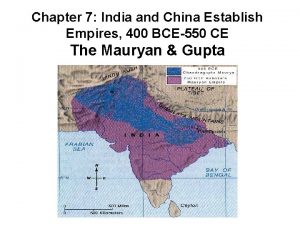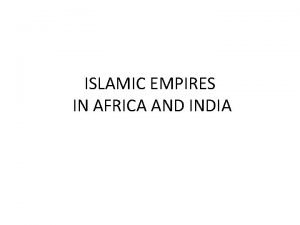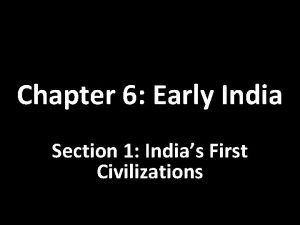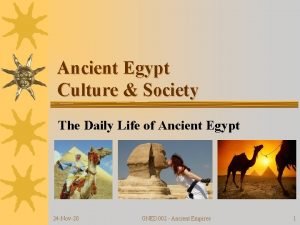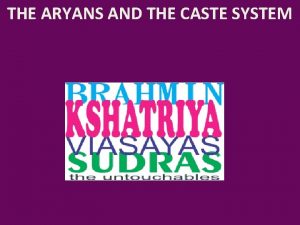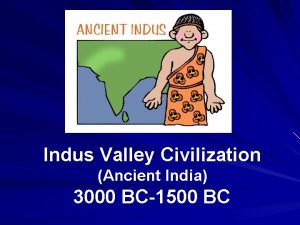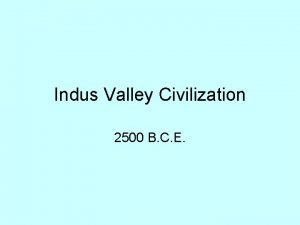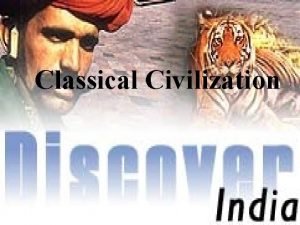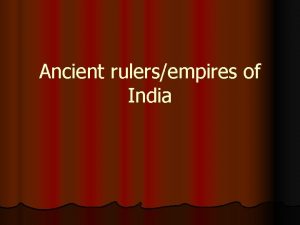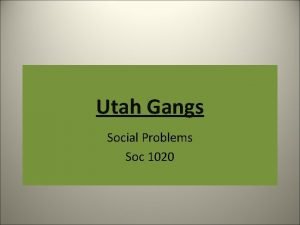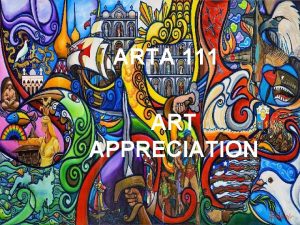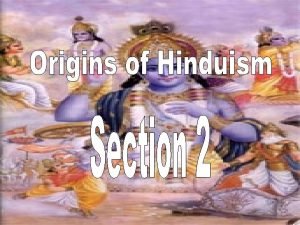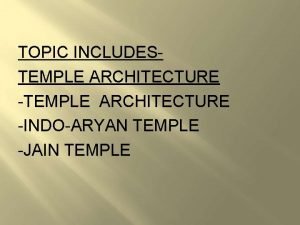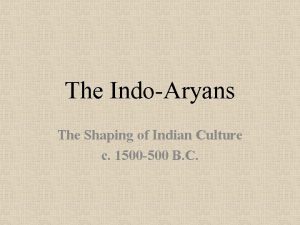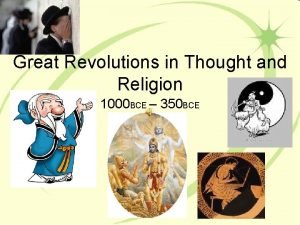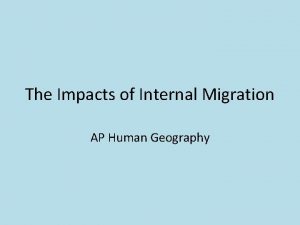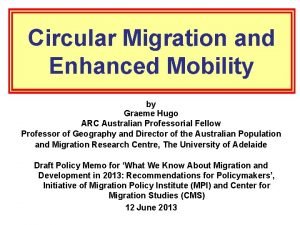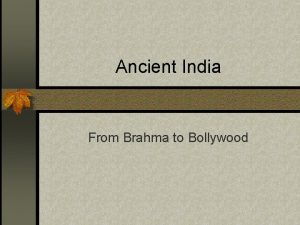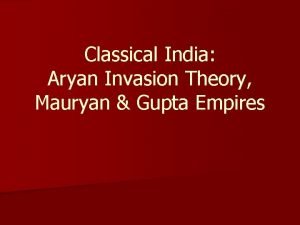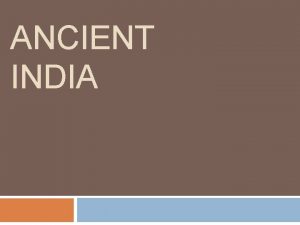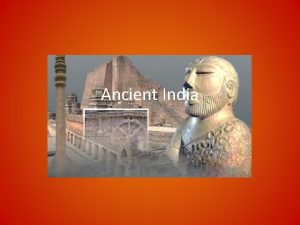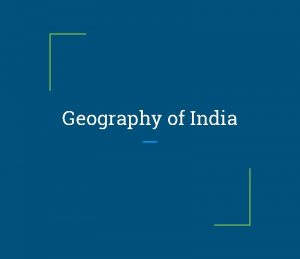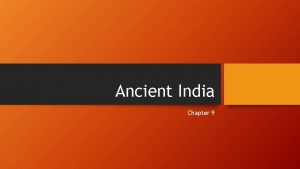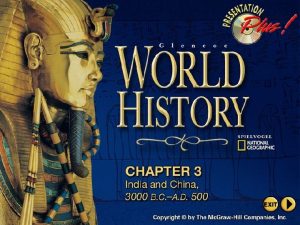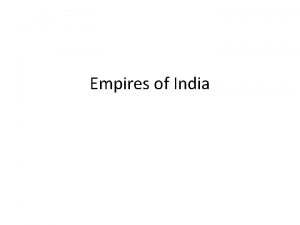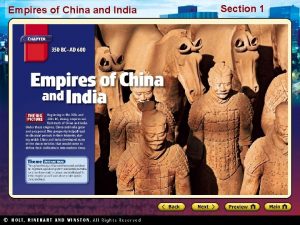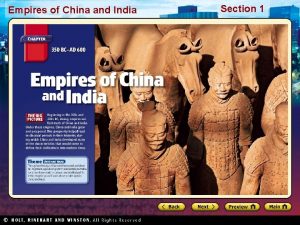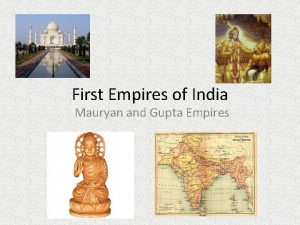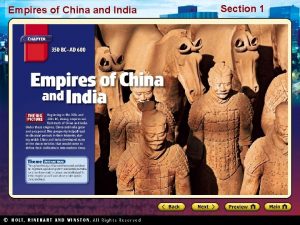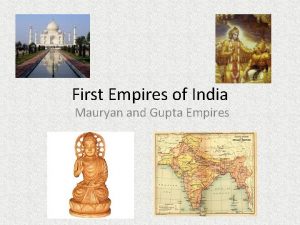Ancient India Geography Aryan Migration ancient Empires and


























- Slides: 26

Ancient India Geography, Aryan Migration, ancient Empires, and Hinduism and Buddhism

Geography of India Indus River Harappa Mohenjo-Daro Ganges

Geography of India Hindu Kush Mtns. Himalaya Mtns. Indus River Harappa Mohenjo-Daro Ganges

Physical barriers that protected India from invasion • The first settled communities were located along the Indus River Valley • This location also provided them with protection – To the north the Hindu Kush and Himalaya Mountains – To the south the Indian Ocean

So how then did people migrate to the Indus River Valley? • Groups migrated into the Indus Valley through the Khyber Pass – A mountain pass that allowed people safe passage into the valley

Origins of Indian Civilization • The earliest civilizations began along the Indus and later spread to the Ganges • The first major cities were Harappa and Mohenjo-Daro (both along the Indus)

Harappa and Mohenjo-Daro • The city of Harappa (ca. 3000 BCE) and Mohenjo-Daro (ca. 2500 BCE) are located in modern-day Pakistan along the Indus River • The two cities had a combined population of nearly 70, 000 • The two cities arguably had the most advanced infrastructure for the time – Example: Grid-patterned layout, standardized weights and measures, etc.

Aryan Migration • The Aryans were Indo. Europeans herders – Constantly searching for water and pasture for their horse and cattle • They utilized chariots and bow and arrows • Most of what historians know of the Aryan’s comes from the Vedas (written by the Aryans and a sacred text of Hinduism)

Aryan Migration • The Aryans took over the Indus Valley and instituted the Caste System • The Caste System was a rigid social structure that organized society by specific classes

Aryan Migration • Each person was born into a caste which determined your job, friends, spouse, and social standing • You could not change your caste except through reincarnation (rebirth)

Hinduism • Hinduism is the oldest “living” religion in the world (originated at least 3500 years ago) • It is the 3 rd largest religion in the world today with over 1 billion followers – 70% of people living in India are Hindu (approx. . 700 million)

Hinduism • There is no single founder or sacred text • It is also difficult to classify in that Hindus believe in many forms of one god (while there are millions of gods they are simply different manifestations of Brahman)

Hinduism: Beliefs • Hindus believe in an allpowerful force known as Brahman – It is the source of all matter (everything) – It is manifested in everything

Hinduism: Beliefs • While Hindus believe Brahman is the source and existence of all being they also believe is Atman • Atman is the “true self” or soul but is not distinct or separate from Brahman • The goal of Hinduism is to unite atman and brahman

Hinduism: Beliefs • When you unite atman with brahman your spirit is freed, this is known as moksha • To reach moksha you must free yourself of desires and you must lose the concept of self • Moksha cannot be accomplished in one lifetime

Hinduism: Karma and Reincarnation • Moksha relies on both karma and reincarnation • Karma is the belief that our thoughts and actions carry consequence • One’s karma affects their reincarnation or rebirth https: //www. youtube. com/watch? v=Uk 7 bi. SOzr 1 k

Hinduism: Purpose of Life • The four objectives of human life according to Hinduism are known as the Purusarthas: – Dharma: religious and moral duties (includes karma) – Artha: material pursuits – Kama: pursuit of sensual please – Moksha: liberation from samsara (wheel of rebirth)

Hinduism: Sacred Texts • While there are many sacred texts in Hinduism the most recognized are the Vedas and Upanishads • The Vedas were written by the Aryans and is the earliest and most sacred – It deals mostly with Hindu rituals and history • The Upanishads are later and focus on the teachings of Hinduism (brahman, atman, samsara, etc. )

Hinduism: Holy Days • Diwali is the most popular Hindu holy day and the most popular festival in South Asia – It is known as the Festival of Lights – It lasts for five days and involves fireworks, lights, dancing and lots of food (particularly sweets) – It celebrates the victory of good over evil (knowledge over ignorance) and is a reaffirmation of hope

Hinduism: How did the religion spread? • Hinduism unlike many other ancient religions spread for the most part peacefully, not through war, conquest or missionaries but through trading

Mauryan Empire (321 -185 BCE) • The Mauryan Empire developed around 322 BCE after the westward withdrawal of Alexander the Great • The Mauryan Empire is believed to be the largest empire in the history of the India (around 50 -60 million)

Mauryan Empire • The Mauryan’s reached their greatest height under Emperor Asoka (Ashoka) • Asoka converted to Buddhism, which was a shift away from Jainism for the Mauryans – This led to an increase in peace and prosperity

Mauryan Empire • The Mauryan’s unified the people of India and were responsible for spreading Buddhism throughout South and Southeast Asia • The Mauryan’s also established free hospitals, veterinary clinics, and roads • The Mauryan Empire dissolved shortly after Asoka’s death and the rise of Shunga dynasty

Gupta Empire (320 -550 CE) • The Gupta Empire marks the “Golden Age” of classical Indian culture – Time of peace and prosperity in India • The Gupta Empire were also credited advancements in math, science, and the arts

Gupta Empire: Contributions • Mathematic contributions included the concept of zero and Arabic numerals* – *Credited to Islam but later historians discovered derived from India • Medical advancements: resetting and casting bones

Gupta Empire: Contributions • Advancements in Science: first civilization to discover the Earth is round • Technology and Literature: created advancements in textiles and literature (erotic poetry and romantic comedies)
 Land empires vs maritime empires
Land empires vs maritime empires Chapter 7 india and china establish empires
Chapter 7 india and china establish empires Ancient india vs ancient china
Ancient india vs ancient china India empires
India empires India's first empire
India's first empire Chapter 7 section 1 india's first empires
Chapter 7 section 1 india's first empires Early empires in the ancient near east
Early empires in the ancient near east Ancient empires jar
Ancient empires jar Where did hinduism originate
Where did hinduism originate The aryan caste system
The aryan caste system Aryan civilization
Aryan civilization Aryan society
Aryan society Aryan dynasty
Aryan dynasty Aryan religion
Aryan religion Aryan mazloum
Aryan mazloum Topography of india
Topography of india Indian social classes
Indian social classes Rose park nortenos
Rose park nortenos Art appreciation subject in college philippines
Art appreciation subject in college philippines Kshatriyas caste system
Kshatriyas caste system Vimal vasahi temple plan
Vimal vasahi temple plan Aryan
Aryan Indo aryan
Indo aryan Four great revolutions in thought and religion
Four great revolutions in thought and religion Internal migration ap human geography
Internal migration ap human geography Migrant labor definition ap human geography
Migrant labor definition ap human geography Circular migration ap human geography definition
Circular migration ap human geography definition

